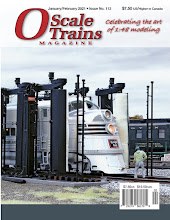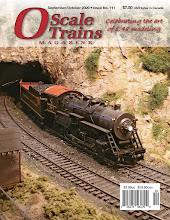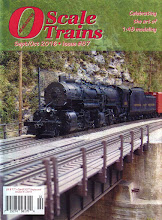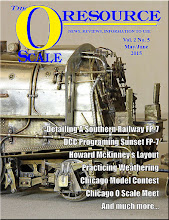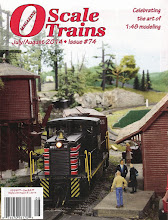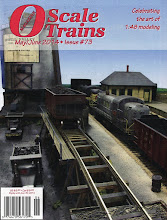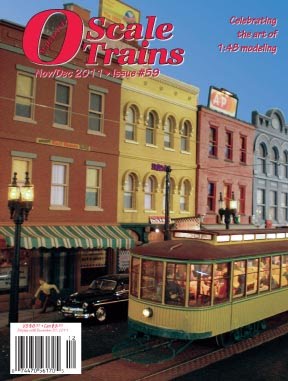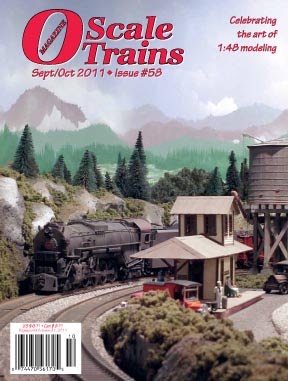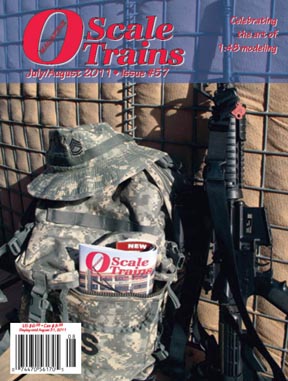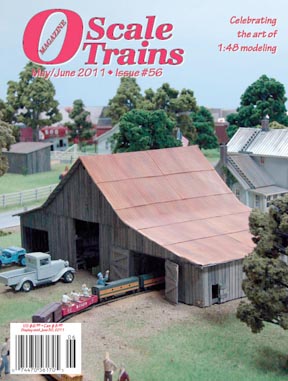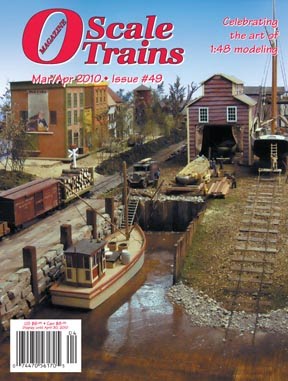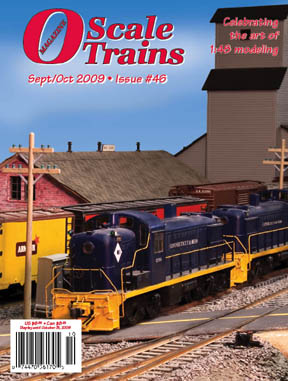I was pretty excited to see them, considering the several rounds of input I gave their graphic artist, Jonathan, to make sure these were right. I see that most of the input was taken and only a few flaws and inaccuracies (which are more than likely the factory's fault) remain. If someone has further issues with the paint job, I suppose the blame is on me, but photos of every unit showed something different and the factory only paints things "one way".
I do plan to take video of these units running under DCC in the future, but I have no track set up at this time to do this.
I also plan to produce a series of videos on how to reprogram a QSI locomotive's firmware to Q3, as well as play with the various CV settings. Look for that sometime in 2017. I believe these are the last 2R units from Sunset to come with the Q2 files loaded into the DCC decoder. The next engines will have Q3 files, which have much better sounds, as well as let the user select 1 of 120+ horns (and 1 of 23 bells) by changing just one CV. Super cool! In any case, if you have QSI Titan decoders and you do not want them, I would purchase them.
Note, the review is not to be overly critical of Sunset or Scott, but examine various items that modelers look at when they look over a model. The closest I got to counting rivets was wondering why one of the door latches on the fireman side was lower than the rest, but supposedly there was a picture of this on one unit, so the tooling stayed that way, though I think that one latch in that one photo was different from the mainstream. Oh well.
Here's a photo essay of what one would see as they received their package from Sunset and unboxed their units...image not big enough? Click each one to enlarge it.
Open the UP end and you'll see a 2R manual. Underneath the white styrofoam lays a well-packed yellow and black 3rd Rail box.
This is the box end for the first model. Looks like Central of Georgia (Peterson Supply company custom run) and Black River and Western (I hear former employees wanted these) were extra paint schemes listed that were not reservable by regular customers.
Inside the yellow/black box is your typical styrofoam container.
Inside the styrofoam is a well-packed train. Use the red ribbons to help lift the model out of the styrofoam...there is foam and cardboard on the top/bottom of the unit, so nothing will damage the locomotive.
Perhaps Scott has a good reason to tape the foam wrapping, but I find it really unnecessary and a nuisance to have to cut open. There is a risk the blade can go through the foam and damage the shell. MTH and Lionel don't do this and don't have any problems.
There was foam everywhere to protect everything, even the step wells. Really nicely done. There was a foam piece with cutouts for the roof too not seen in the photo.
Oh no, a screw fell out as I took the engine out of its foam cradle. Luckily it was a very easy to spot hole in the truck and I put it back in with no problem.
Here is a parts goodie bag. Not sure what the screws are for exactly (would have been nice to have that in the manual), but there is also the magnetic bar used to change the volume and reset the locomotive for those who don't have DCC.
Let's start with a nice shot of the cab. Paint is relatively crisp and matches the artwork Jonathan did up. And I just realized the middle step on my units were glued into the wrong place. I was able to easily take one off, but it left glue residue. I will need to remove all of these middle steps, file/sand down the glue residue, repaint, re-add steps, and weather. An unfortunate mistake by the factory that was missed at QA.
Roof Shot. Everything laid out well. These units prototypically had:
- Spark arrestors over their stacks,
- a firecracker antenna up front, and
- two horns, a Leslie A-200 and Nathan M-5. I plan to replace the M5 with a cal-scale casting for further accuracy.
Here are both broadside views of the locomotive's fireman and engineer's sides. The bell is higher than the antenna, which is good from photos I referenced. The wrongly-placed steps stick out in this image.
Here are the front and rear images together.
- Note the correct SD9 markers.
- Jonathan thankfully and correctly fixed the tiger striping to not cover the MU boxes and the handrail colors/coloring (to make them white and only white in certain parts).
- The bell looks real good. They were reused from old Southern steam locomotives.
- The missing ladder on the right side is also prototypical.
- The grab-iron at the top of that side should also be missing.
- The numberboards should have the numbers written from the outside edge instead of centered, but I guess the factory didn't understand that request either.
- The bell should be black. The artwork is right, but the factory didn't listen again? Le sigh.
Looks like someone left their inspection sticker on one of my two models. It came off without a problem.
This grab-iron should have never been added, but my guess is that the factory didn't understand the direction given. Not super happy this happened, but I plan to remove this, fill the holes, and sand off the NBW castings.
The bell does look good though. Should be black though.
This is 3rd rail's attempt at spark arrestors. They look good for the general shape, however the smooth surfaces should all be wire screened, which are not on these models. I plan to replace these with my own brass versions.
One of my couplers was not properly installed or came loose in shipping. That's okay, they're 805's. I will replace with the nicer 745's, as I do on all of my locomotives.
Locomotive #2's box after it was removed from the shipping box.
The firecracker antenna was found bent. Luckily it bent back into shape without breaking.
Good thing for all of the foam. The rear handrail set was bent inward, but easily bent back. The red line shows the proper angle they should be at.
So this the second of three aesthetic problems I'm not super happy with. I forgot to photograph the 4th set of cab numbers, but the point is that assuming it was also 100% correct, there is a 50% error rate on the decal job.
- The upper left looks great.
- The G looks like a C in the upper right.
- The period is missing next to the G in the bottom left and the #2 is missing part of its decal.
I have two decisions to make…Scott did get back me to already and said he should have decals available when he gets back from China. Or I can investigate relettering my units to CofG (black-tux).
This is the last of aesthetic nightmares and not easily fixed. This is only one example of this, but the pilot boards were not see-through on every pilot board (and step-holes for that matter). I was hoping it was just paint clogged in the hole, but nope, my exacto blade is telling me that is metal, so solder go in there and the factory didn't go back and remove it. This is on most of the pilot boards. I will have to see if the step-holes is also solder or paint.
This is unfortunately one problem I can't easily fix without ruining the factory paint. Since these units will probably get heavy weathering, I may be OK to try to remove the solder on the pilot steps, since they will get repainted. Not happy, but its not a super huge concern compared to the lettering, steps, or roof grab-iron.
I did not take this unit apart yet to check out the cab interior, but I will do that later after I throw some power on these units.
Overall, these are really nice models for the money. Many people, Scott and Jonathan especially, put a lot of effort into getting these units ready for us, which I really appreciate. They provided a really good base for me to just need to add a little of my flavor to get them closer to brass quality.
Here is a summary of what I feel I need to do to these units to get them up to my standard:
- Swap out Kadee 805s to 745s.
- Swap out Nathan M5 casting with a bowser cal-scale casting.
- Swap out cab shades with my own Southern Prototypical brass castings.
- Swap out the spark arrestors with my own Southern Prototypical brass castings.
- Remove all traces of the rooftop grab-iron on the front.
- Repaint and Redecal the numberboards so that the numbers are on the outsides of the boards.
- Paint the bells black.
- A quick mystery item that is shown below...
- Either fix the lettering w/ Scott's help or redo the lettering to CofG (black tux)
- Remove solder from the various pilot-step holes. Repaint.
- Remove either paint or solder from the round side-step holes using a drill bit. Repaint.
- Fix the middle steps on all units...remove, remove glue, repaint, reglue.
- Weather.
That will all take what..21 hours for both units maybe? Give another couple of hours to reprogram the units to Q3 files, modify the CV's to my taste.
I just hope I don't find anything else.
And here is the parting shot...twins side by side, awaiting some of their owner's fine touches before their first assignment. I do plan to use these units primarily consisted together with no other units.
Oh and before I forget...here's an I-spy for everyone....what do you see on unit 206 that should be on unit 203?!?!?!?!
.
.
.
.
.
.
.
.
.
.
.
.
.
.
.
.
.
.
.
.
.
.
.
.
.
.
.
.
.
.
.
.
.
.
.
.
.
.
.
.
.
.
.
.
.
.
.
.
.
.
.
.
.
Give up? The pilot step side-walls on 203 never got painted white! Glad that is an easy fix. I hope Scott's new factory can learn from these mistakes and not repeat them in future releases.























